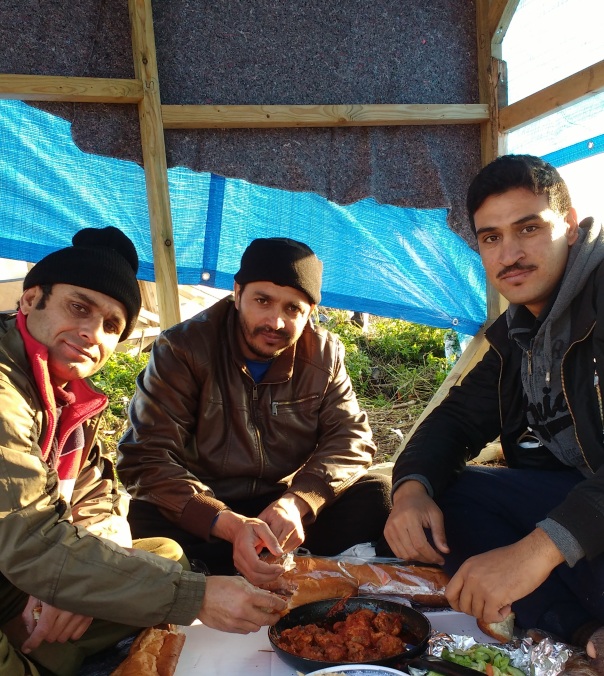The journey starts at midnight on Sunday. We have a ton of dried and tinned food on board and wood to build 10 shelters – all paid for by donations from our local community. The roads are clear and we make good time to Folkestone; by sun-rise we are already in Calais.
I am a 25 year old graduate, living with my parents in Somerset while I study to be a counsellor. Here, I can save money and study in safety and comfort. I live just a four-hour drive and 20 minutes on the Eurotunnel from Europe’s biggest refugee camp – home to over seven thousand refugees. I went because the people there need help. What I experienced shocked and inspired me and I’ll be going back every month until conditions improve.
After joining up with the small charity Auberge des migrants International, I enter the Jungle in the back of a van. I’m sitting on a roll of insulation and I can see timber, plastic sheeting and various tools. After ten minutes or so I know we have entered the Jungle when the van slows and the ride gets bumpy. I have no idea what to expect when the van stops. The door finally opens. I step down into the mud. Around me I can hear hammers and saws and smell the delicious aroma of chapattis and breakfast cooking. And then, the reek of overflowing portaloos. A man cycles carefully through a puddle in the road, a water container balanced between his knees. A volunteer listens to a group of refugees and writes lists in a notebook.
While I wait for instructions I get talking to an Eritrean named Afwerki, who pokes his head out of a doorway. He is wearing a grey hoodie, jeans and immaculate white trainers, all donations from Auberge. He tells me he has been in the camp for three months, trying to find a way to the UK.
My shelter tenants arrive. They have been on a waiting list for some weeks and they are keen to get started. We carry materials through the narrow paths between existing constructions to a plot where refugees are making space for the shelter. Previously used as landfill, the site is pock-marked with trenches and littered with rubble. It’s hardly ideal land to build on. Very little is ideal about the Calais Jungle.

After learning how the structures are assembled, I am sent off to start the second shelter. I meet Hakim, Kamal and Tahir, three brothers from Afghanistan. Together we start the day’s second build. As the structure takes shape, I learn that Hakim, the oldest, was a commando in the Afghanistan army before fleeing the country. He wants to get to Canada, while his brothers aim to meet family already in the UK.
At midday, I give Kamal some cash and mime for him to find some lunch for the four of us. By now we have joined the wall-timbers and the rafters are in place. We stretch blankets over the wooden frame, before wrapping the whole structure in waterproof plastic wrap. The floor is made out of pallets, and the inside is clad with rolls of insulation made from recycled clothes and rags.

We are on the northeast edge of the camp. This side faces away from the main road where the French authorities have erected tall razor-wire fences between the refugees and the passing lorries, on their way to the ferries and the Eurotunnel. Here you can see out across the flat fields of Nord-Pas-de-Calais. My eye is drawn to a solitary portaloo, wrapped in a torn blue tarp that billows in the wind. The smell is a constant reminder of how under-provisioned the Jungle is. Neither the UN nor the big aid charities are here. Small charities like Auberge struggle to fill the void while the so-far mild winter could turn cold any day.
Over an hour has passed since Kamal went off. My stomach rumbles; I begin to wonder whether he has pocketed the cash and legged it. We fix thick marquee-like material to the rafters and nail on the door.
My doubts about Kamal vanish as I see him round the corner of a hut carrying a large cardboard box. He picks his way through the rubbish towards us, stepping over broken tent poles and piles of cast-out food remains.
We clear the floor of the half-finished hut and spread a blanket on the ground. The brothers and I take off our shoes and sit down. Kamal places a baguette in front of each of us, and then he takes a pan of Afghan chicken, rice and salad from the box. I am given the biggest piece of chicken. It is delicious – I say so and they all smile. The low sun warms us as we eat and the brothers teach me the Pashto for “chicken”, “rice” and “thank you”. They laugh at my attempts as they wipe clean the pan with hunks of baguette. I suspect that Kamal has spent more than I gave him, but he refuses to accept any more money.

At the end of the meal, Hakim says “God is great” and we continue to build. I reflect on the times I have carried out building projects with my brothers in Somerset. I am so close to home here. This country is familiar to me, but the Jungle is not the France of my childhood holidays.
Later on I meet an Iranian outside the Ashram Kitchen, a large tent where volunteers serve free meals to all comers. He tells me “I had a good job as an engineer in Iran, how did I end up here?” It is a story that I keep hearing.
***
The following day when I enter the camp, the atmosphere has changed. We hear rumours that a young Sudanese man was murdered when a fight got out of hand. Groups of stoney-faced riot police block roads in the camp while they investigate. They unearth no evidence and leave, restoring the Jungle to its own laws.
It’s raining. The ground turns treacherously slippery and the smiles and productivity of yesterday seem an age ago. I am with Conrad and Mark. Our job is to deliver extra materials to three of yesterday’s self-builds, before making the journey home in the afternoon.
We drive past the building site funded by the European Commission over three months ago. Five million euros (£3.6M) in August this year to build large tents and facilities to house 1500 refugees. Since then the population of the camp has more than doubled and the buildings are not yet out of the ground. We pass a man in high-vis sitting in a stationary digger. He watches refugees file by towards a truck handing out tins of food. An hour later, we pass him again – still doing nothing.
The Jungle too moves at it’s own pace and we wait for a sewage truck to empty a row of overflowing portaloos. I turn around and see a man unloading the wood from our trailer and stashing it behind a hut. I run over to get the wood back, followed by Behrouz, the young man the wood is intended for. A scuffle ensues as Behrouz realizes that some tools are still missing. Behrouz reaches into his coat; the thief follows suit as they shout in rapid Farsi. Mark manages to get between them and the situation diffuses. The sewage truck moves on to let us pass. I am struck by the absurdity of our work here; who are we to say who deserves and who doesn’t?
Everyone seems to be coughing today. One volunteer at the Ashram Kitchen tells me that TB is going around the camp, as well as scabies; an itchy condition caused by mites that burrow into the skin. The poverty of the Jungle is the perfect breeding ground for Cholera; polluted water and people with ever-decreasing immune systems. Many have died here already; the winter will claim many more.
It is a relief to drive out of the camp for the last time. Tired and muddy, we head towards home.
David Cameron recently asked how we can stand by while our allies take the fight to Isis. What about our responsibility to help those displaced by the same conflict? Last year the UK accepted 10,050 non-EU asylum seekers; a quarter of those taken by Germany; less than half the number accepted by Italy, with its struggling economy, and 4000 fewer than France.
Britain and France are building fences and hoping the situation will go away. It’s not going away. It has to be addressed. If not now, when?
You can donate here to buy tools and materials for the builds.

























